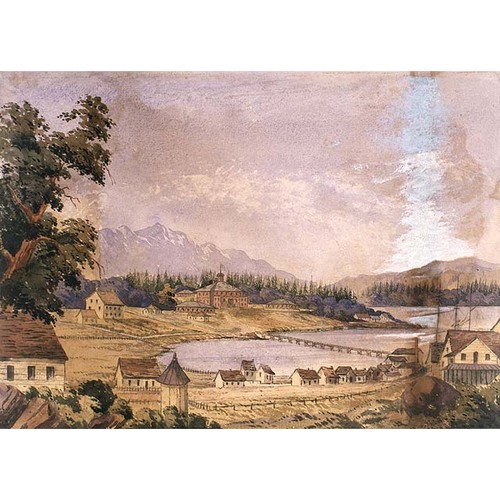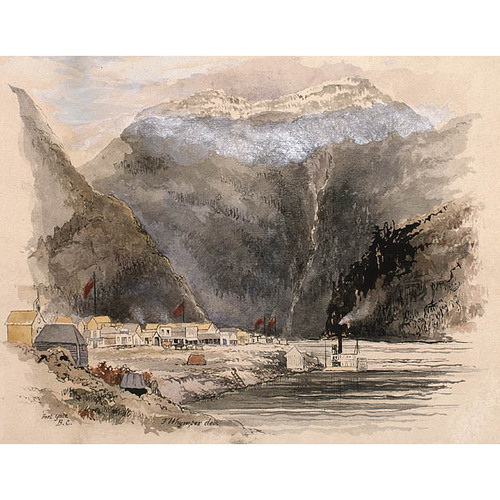
Source: Link
WHYMPER, FREDERICK, artist and author; b. 1838 in London, England, eldest son of Josiah Wood Whymper and Elizabeth Whitworth Claridge; d. there 26 Nov. 1901.
Frederick Whymper was the son of a celebrated wood-engraver and artist and the brother of Edward, the renowned Alpinist. As a young man he worked with his father and brother in producing engravings for several publications. From 1859 to 1861, more-over, he exhibited his landscapes at the Royal Academy of Arts.
Whymper arrived in Victoria in the autumn of 1862, and the following summer he travelled to the Cariboo district of British Columbia on what he described as “a sketching and pedestrian tour.” He remarked that “many claim holders and mining companies in the upper country” commissioned drawings from him, and this fact may explain why his drawings seem intent on topographical precision. Whymper also made “sketches and sets of drawings” for some of Victoria’s leading citizens, including future chief justice Matthew Baillie Begbie* and Donald Fraser*, a former member of the Council of Vancouver Island.
After a second winter in Victoria, Whymper set out in March 1864 for Bute Inlet (B.C.), in order to publicize through his drawings the road that Alfred Penderell Waddington* was attempting to build to the Cariboo. He dutifully gave good reports of the enterprise, but attracted more attention from his account of the background to the killing of workers on the project by Indians [see Klatsassin*], which had occurred while he was leaving the region. Despite the sensation, Whymper’s work was not overlooked. The Victoria Daily Colonist noted his drawings of “the windings of the trail and . . . [its] formidable obstacles” and his renderings of “magnificent glaciers.”
Soon after he arrived back in Victoria, Whymper applied for the position of artist on the Vancouver Island Exploring Expedition [see Robert Brown*]. Of wiry build, he accepted the rigours of an expedition which covered much of the southern part of the island. An exhibition of 33 of his drawings from the exploration was held in Victoria in November 1864. In 1865 Whymper joined the Russian-American Telegraph project, which intended to construct a telegraph line linking the United States and Europe through British Columbia, Alaska, and Siberia. As its artist he went to Norton Sound (Alas.) during the summer and then crossed to Petropavlovsk (Petropavlovsk-Kamchatskii, Russia). Following a winter in San Francisco, he again set out for Petropavlovsk and subsequently travelled around the Gulf of Anadyr (Andayrsky Zaliv, Russia). Near the end of October 1866 he crossed to Mikhailovski (St Michael) on Norton Sound, and after a winter at Nulato he ascended the Yukon River to Fort Yukon, where he received news of the successful laying of a transatlantic telegraph cable [see Frederic Newton Gisborne*]. On his return to Mikhailovski in August 1867 he was told of the abandonment of the Russian-American project.
Whymper went back to England in November 1867, and his narrative Travel and adventure in the territory of Alaska (London) was published the following year. Four chapters are concerned with his travels in British Columbia and Vancouver Island, and the book is illustrated with drawings of these regions. In 1869 Whymper returned to San Francisco by way of New York and worked on the staff of the newspaper Alta California. City directories describe him as an artist and mining engineer, and in 1871 he was a founding member of the San Francisco Art Association.
The publication of others of Whymper’s writings in England from the mid 1870s suggest that he had left North America by then. These books were essentially works of popular education, as indicated by the titles of two of them: The heroes of the Arctic and their adventures (London and New York, 1875) and The sea: its,stirring story of adventure, peril & heroism (4v., London, 1877–80). They are sometimes illustrated by his drawings, but by the time the books appeared Whymper seems to have given up drawing for writing and to have settled down. The cause of his death in London was described in an obituary as “failure of the heart, probably due to indigestion, arising from sedentary pursuits.”
It is significant that when Whymper had returned to North America he had lived in San Francisco rather than Victoria. Travel and adventure reveals that he was condescending about society in Victoria while accepting its patronage and hospitality, and that he assumed British North America would be absorbed by the United States. None the less, he drew attention to British Columbia, most notably through engravings of his drawings. These engravings appeared not only in his own publications but also in Robert Brown’s The countries of the world (6v., London, [1876?–92?]), Gilbert Malcolm Sproat*’s Scenes and studies of savage life (London, 1868), and the Illustrated London News.
Whymper was not averse to commercial enterprise; his drawings publicized a road to the Cariboo, its mining settlements, and possibilities for development on Vancouver Island. He was, however, also attracted to the sublime. He turned from Waddington’s road for an excursion to a glacier which “very much resembled . . . the Mer de Glace,” a celebrated glacier near Chamonix-Mont-Blanc, France. Bute Inlet reminded him of some lines of Tennyson: “Water between walls / Of shadowy granite, in a gleaming pass.” Although many of Whymper’s drawings have documentary value rather than artistic merit, there are instances when his different interests find effective expression, as for example in the depiction of a trail precariously edging a deep gorge at the head of Bute Inlet or the peaks towering above the modest settlement of Yale. In such drawings, Whymper expresses the problem confronting settler and artist alike, that of coming to terms with a potentially overwhelming environment.
The bulk of Frederick Whymper’s drawings are preserved in the Visual Records Unit at the BCARS, the Bancroft Library, Univ. of California (Berkeley), and the Beinecke Rare Book and ms Library of Yale Univ. Library (New Haven, Conn.). The following institutions also hold a few of his works: the Calif. Mt. Soc. (San Francisco), the Glenbow Museum (Calgary), the Documentary Art and Photography Div. of the NA, the Royal Geog. Soc. (London), and the Scott Polar Research Institute (Cambridge, Eng.). A partial list of Whymper’s sketches and engravings after them appears in Helen Bergen Peters, Painting during the colonial period in British Columbia, 1845–1871 (Victoria, 1979), 76–77. A checklist of drawings relating to the Vancouver Island Exploring Expedition is included as app.2 to Robert Brown, Robert Brown and the Vancouver Island Exploring Expedition, ed. John Hayman (Vancouver, 1989), 201.
Whymper’s letters of application to the Vancouver Island Exploring Expedition and his expedition journal are in the Robert Brown coll. at BCARS, Add. mss 794, vol.3, files 4 and 9.
Several further editions of Whymper’s 1868 account, Travel and adventure in the territory of Alaska, formerly Russian America – now ceded to the United States – and in various other parts of the North Pacific, appeared between 1869 and 1871. Two French translations of it were published (Paris, 1871, and an abridgement, 1880), and a German one was issued at Brunswick, [Germany], in 1869. One of his later works of popular history, The heroes of the Arctic and their adventures, went through ten editions, the latest revision appearing at London and New York in 1899.
Whymper’s publications include a few additional monographs written after his return to England, as well as several articles on his North American travels in various journals and in the anthology Illustrated travels; a record of discovery, geography, and adventure, ed. H. W. Bates (6v., London, [1869–75?]), vols.1–2. A list of his publications relating to the northwest coast may be found in the Bergen Peters study cited above, pp.75–76; listings for his books appear in The British Library general catalogue of printed books to 1975 (360v., London, 1979–87), Canadiana, 1867–1900, and the CIHM Reg.
B. C. Gilmore, Artists overland: a visual record of British Columbia, 1793–1886 (Burnaby, B.C., 1980). J. B. Stanton, Impressions of an age (Vancouver, 1969). Maria Tippett and Douglas Cole, From desolation to .splendour: changing perceptions of the British Columbia landscape (Toronto, 1977).
Cite This Article
John Hayman, “WHYMPER, FREDERICK,” in Dictionary of Canadian Biography, vol. 13, University of Toronto/Université Laval, 2003–, accessed December 30, 2025, https://www.biographi.ca/en/bio/whymper_frederick_13E.html.
The citation above shows the format for footnotes and endnotes according to the Chicago manual of style (16th edition). Information to be used in other citation formats:
| Permalink: | https://www.biographi.ca/en/bio/whymper_frederick_13E.html |
| Author of Article: | John Hayman |
| Title of Article: | WHYMPER, FREDERICK |
| Publication Name: | Dictionary of Canadian Biography, vol. 13 |
| Publisher: | University of Toronto/Université Laval |
| Year of publication: | 1994 |
| Year of revision: | 1994 |
| Access Date: | December 30, 2025 |





